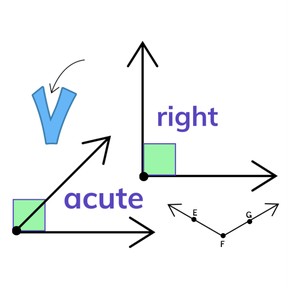
Domain-specific words/phrases: geometry and angles
I can define domain-specific words in my textbooks in the math area of geometry.



8,000 schools use Gynzy
92,000 teachers use Gynzy
1,600,000 students use Gynzy
General
Students learn to determine domain-specific vocabulary and focus on learning domain-specific vocabulary for math, specifically geometry. They will learn about right, acute, obtuse, and straight angles.
Standards
CCSS.ELA-Literacy.RI.4.4
CCSS.MATH.CONTENT.4.G.A.1
Learning objective
Students will be able to define domain-specific words related to geometry, specifically angles.
Introduction
Ask students to imagine a dinosaur. What kind of dinosaurs are they imagining? Explain that domain-specific vocabulary means using more precise vocabulary- so saying a Stegosaurus, for example, instead of a dinosaur. Look at the three sports images shown on the interactive whiteboard and discuss some of the domain-specific vocabularies for each sport. Do the students know any other domain-specific vocabulary for these sports? Explain that by understanding the domain-specific vocabulary, they become successful at understanding a specific task or exercise and can better complete or do what is asked of them.
Instruction
There are different ways in which to learn domain-specific vocabulary words. They can learn from diagrams or pictures in their textbooks, from a teacher or coach, or from a glossary. One great way to expand your vocabulary (and also your domain-specific vocabulary) is to read! Ask students to match the given words to the specific domain they refer to. Then move on to math. Explain that geometry has a lot of domain-specific vocabulary and that you need to understand these words to be able to understand geometry. Teach the word 'point' and practice using it on the interactive whiteboard. Next teach lines, line segments, and rays. After that, explain that the point at which two rays meet is called a vertex, and this is part of an angle. Talk to students about how angles are all around us. Have students trace the angles on the objects on the interactive whiteboard and challenge students to find a few angles in the classroom. Next, explain to students that there are different kinds of ways to discuss angles and the important domain-specific vocabulary words are right, straight, acute and obtuse. Have students stand up and stretch! Can they make the angles given with their bodies/hands/arms? Next, ask students to adjust the clock to make the given angles. Students are then given a selection of everyday objects and are asked to sort them into their correct angle type.
Quiz
Students are given a selection of multiple choice and true/false questions in which their knowledge of key concepts is checked. They must determine which vocabulary is domain-specific, or suggest the domain to which a specific word belongs, and must define what domain-specific vocabulary is.
Closing
Restate the learning goal with the students and discuss how they can find, learn and apply domain-specific vocabulary. To close the lesson, ask the students to write their names in angles. How many angles do their names have? What kind of angles do their names have? You can choose to have students decorate their names or write on graph paper. You can also add a page and use our lines to have students write their names on the board.
Teaching tips
If students already understand what domain-specific vocabulary is, you can choose to only focus on the Geometry-related portion of the lesson. If you do so, quiz questions 1, 2, 3, and 9 do not relate to maths.
The online teaching platform for interactive whiteboards and displays in schools
Save time building lessons
Manage the classroom more efficiently
Increase student engagement
Discover more!
About Gynzy
Gynzy is an online teaching platform for interactive whiteboards and displays in schools.
With a focus on elementary education, Gynzy’s Whiteboard, digital tools, and activities make it easy for teachers to save time building lessons, increase student engagement, and make classroom management more efficient.



